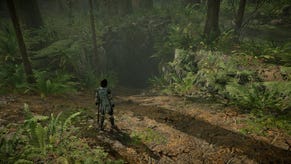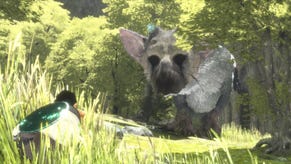Design in Action | The Last Guardian: How to be Trained by Your Dragon
Or: How the players got played.
This article first appeared on USgamer, a partner publication of VG247. Some content, such as this article, has been migrated to VG247 for posterity after USgamer's closure - but it has not been edited or further vetted by the VG247 team.
The Last Guardian may well be the first game I've ever played that revolves around the concept of trust. The trust begins with an act of mercy: The boy frees Trico, who has been mutilated and shackled, despite the fact that even in its hobbled state the creature clearly possesses tremendous power and could easily hurt or even kill him. And Trico slowly comes to trust the boy, its body language changing over time from wariness to curiosity to ease. The true change in the game's design — the point at which the adventure ceases to be a matter of the boy picking his way through puzzles as a wounded creature pads along behind him — comes when you reach a dead end and Trico unexpectedly plucks the boy from the ground, taking the initiative to forge the way forward itself.

Again, this moment is completely scripted, but it signals to the player that the game has fundamentally changed. To underscore the point, the narrator (the boy, reminiscing as an adult) muses over his realization that Trico could understand his directions. From this point forward, you work as a team with this AI character. Again, that in itself is nothing new, precisely; Ueda made his mark with Ico, a game that centered on the novelty of an AI companion who played a participatory role in the adventure. And escort missions in which players guide and protect an AI character have long been the bane of video game fans everywhere.
What makes The Last Guardian stand apart is that its quest is as much as an escort mission for Trico as it is for the boy. There are times when you need to rely on Trico to advance the story, but then the roles reverse and Trico waits patiently while the strange little creature that rides on its back tries to puzzle out some small mechanism or passageway so that Trico can lead the advance to the next area. For the first time I can recall, The Last Guardian frequently casts the player in the role of the dumb companion character, holding up progress while the hero sits and waits for it to do the correct thing. It works the other way as well, sometimes to the game's detriment: You'll encounter many scenarios where you can clearly see the path forward but have to wait for Trico to obey your commands the way you intended. Again, trust works both ways in The Last Guardian.
The back-and-forth design of the lead action in The Last Guardian opens up a constantly shifting sense of scale that you rarely see in a game about navigational puzzles. The boy leads in interior spaces, in cramped quarters, and in areas packed with fiddly objects to manipulate. When Trico takes the lead, however, you bound across vast chasms and climb soaring towers, clearing spaces in a matter of seconds that would take the boy alone hours (if he could even conquer them on his own at all). We've seen this sort of alternating scale in shooters, e.g. Tribes and Halo, but never in a game like this. The Last Guardian is at once intimate and grand... and if the player has to sit in a passive role during moments of grandeur, so be it.
The need to rely on Trico creates an intriguing sense of unpredictability throughout the quest. You never really know how the next scenario will play out. Before long, you'll find Trico takes the initiative to do more than simply clear a high jump: It will sometimes take the lead for extended sequences, bypassing buildings that you assumed would be your next destination or moving you from one side of the mysterious valley all the way to the other. And Trico itself is never entirely predictable. No matter how tight the bond grows between boy and creature, no matter how the beast appears to suffer and sacrifice to protect the child, the game never lets you forget that Trico is not truly under your control. The mysterious towers are loaded with symbols and mechanisms that cause Trico to cower, raise its hackles, and sometimes even "eat" the boy. And though Trico doesn't actually hurt the boy, your constant awareness that you have to rely on a creature that could go berserk at any moment creates a genuine tension at all times. Sure, it's all an illusion — but what game isn't? And few have ever created the complex mix of emotions that The Last Guardian engenders by sometimes asking the player to step back and trust a fantastic, imaginary beast.
Next time: The extraordinary in the ordinary.







